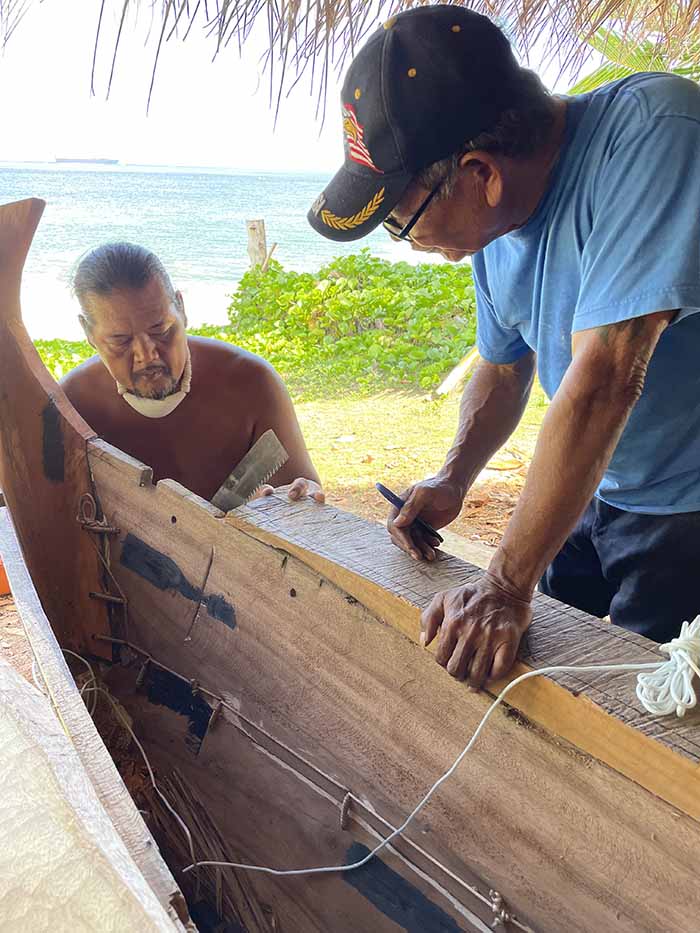An anthropology major apprentices to learn traditional survival skills
An anthropology major apprentices to learn traditional survival skills
An anthropology major apprentices to learn traditional survival skills
3/29/2022

By Akina Chargualaf

Saipan native Tyler Warwick was living in California studying biology in a community college when he found himself homesick. It started with a trip home to Saipan in the summer of 2018, when he came across Antonio Urmeyang “Tony” Piailug, a master canoe carver and traditional navigator, building a traditional canoe house called an utt.
“I went to the canoe house to take pictures and ended up meeting Tony Piailug,” Warwick says. “He was carving there, so I started asking questions and I offered him my hand.”
Warwick was intrigued by what he observed — “I have never seen anything like it before. The utt has no nails and everything was lashed together,” he says. He remembers Piailug was very welcoming, inviting Warwick to come back to learn more if he was interested.
Six days after returning to California from his summer trip, Typhoon Yutu hit Saipan, leaving Warwick with an even stronger longing for home.
“When I went back to California, I wasn’t the same. I was homesick and I was really hurt because I knew I wasn’t supposed to be there. After I completed my obligations, I knew that I wanted to go home and learn all that,” he says.
A hands-on approach to learning

He started as a volunteer with the Seafaring Traditions Program, led by John Castro with Piailug providing direction as the master carver and navigator, under the CNMI Council for Arts and Culture, and has become a full-time trades helper. Their small team of five constructed a canoe house and are carving a 34-foot canoe from the wood of a breadfruit tree using traditional tools.
“People are always looking at jobs and money and forgetting about basic survival skills, like getting shelter, how to find food, and how to build your house,” Warwick says. “This is basic cultural survival. If you don’t have anything, this is where you start.”
Their hope is to ship the canoe to the Festival of Pacific Arts in Hawaii in 2024 and potentially paddle it back to Saipan.
Through the guidance of his mentors Castro and Piailug, he has learned how to lash together an utt, how to sharpen blades and care for the traditional tools, and how to carve. Additionally, the experience has taught him other traditional survival skills, including how to identify plants and basic navigational knowledge, which Warwick considers an invaluable skill that everyone should have.
He says it’s important to pass this knowledge down to the next generation because as the world advances technologically, these skillsets remind people how to live independently.
A broader exposure through the UOG Anthropology Program

“The most valuable part of the UOG Anthropology Program has been studying under the instruction of [Associate Professor of Archaeology and Micronesian Studies] William Jeffery and [Associate Professor of Anthropology and Micronesian Studies] David Atienza,” Warwick says. “Their skill and knowledge […] have exposed me to many aspects of Micronesian history that I feel I did not know much about.”
Additionally, he said their guidance has been valuable in preparing him for career possibilities after graduation.
While he’s not sure yet what his career path may bring, his goal in the near term is to continue learning these traditional skills.
He is also learning about collections care, conservation, and exhibition development as one of 20 individuals selected for a first-time museum institute through the University of Hawaiʻi. The institute is specifically for mid-career indigenous Native Hawaiian and Pacific Islanders. The six-month program will conclude in July.
“I want to learn how to showcase and build an exhibit that will tell people more about the living cultural heritage that goes on in our canoe house,” says Warwick, who hopes his experience with the institute will help pass along skills and knowledge that once sustained his ancestors.
“I think it’s important because it’s a part of us — it is our identity,” he says.
Time lapse video of building an utt
Video courtesy of the Seafaring Traditions Program





